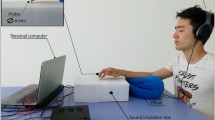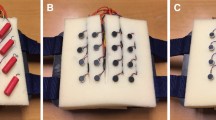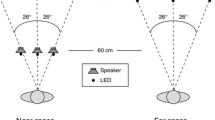Abstract
In this study we investigated audiotactile spatial interactions in the region behind the head. In experiment 1, participants made unspeeded temporal order judgments (TOJs) regarding pairs of auditory and tactile stimuli presented at varying stimulus onset asynchronies (SOAs) using the method of constant stimuli. Electrocutaneous stimuli were presented to the left or right earlobe while auditory stimuli were presented from just behind the participant’s head on either the same or opposite side. Participants responded significantly more accurately when the stimuli were presented from different sides rather than from the same side. In experiment 2, we used a distractor interference task to show that speeded left/right discrimination responses to electrocutaneous targets were also modulated by the spatial congruency of auditory distractors presented behind the head. Performance was worse (i.e. response latencies were slower and error rates higher) when the auditory distractors were presented on the opposite side to the electrocutaneous target than when they were presented on the same side. This crossmodal distractor interference effect was larger when white noise distractors were presented from close to the head (20 cm) than when they were presented far from the head (70 cm). By contrast, pure tone distractors elicited a smaller crossmodal distractor interference effect overall, and showed no modulation as a function of distance. Taken together, these results suggest that the spatial modulation of audiotactile interactions occurs predominantly for complex auditory stimuli (for example, white noise) originating from the region close to the back of the head.






Similar content being viewed by others
Notes
It has been argued previously that the measure of the slope may provide a more sensitive measure of the underlying psychometric function than the JND (Spence et al. 2001), even though the latter measure is more frequently reported (and analysed) in the published literature. Therefore, we also conducted a similar analysis of the slope data. Once again, a significant difference between the data from the same (M=0.012) and different (M=0.014) positions conditions was reported (t(9)=3.08, P=0.01).
The significance of the crossmodal distractor interference was confirmed by means of three-way ANOVAs performed on the RT, error, and IE data, with the within-participants factors of the Relative stimulus position of the electrocutaneous targets and auditory distractors (same versus different side), the Distance between the loudspeakers and the participants’ heads (near versus far), and the Sound type (noise versus tone). Analysis of the IE data showed a significant main effect of the Relative stimulus position (F(1,63)=43.29; P<0.001), with worse performance when the auditory distractors were presented from the opposite side to the electrocutaneous targets than when they were presented from the same side. Analysis of the median RT and error data also revealed a main effect of the Relative stimulus position (F(1,63)=29.92; P<0.001, for RT; and F(1,63)=23.93; P<0.001, for the error data). A significant main effect of the Distance was observed for the IE data (F(1,63)=4.58; P<0.05), and for the Median RT data (F(1,63)=4.01; P<0.05). Neither the main effect of Sound type nor the three-way interaction between all of the factors reached significance in any of the analyses.
The same analyses were conducted on the median RTs and error rates. A significant main effect of Sound type was also observed for the median RT data (F(1,27)=6.75; P<0.05), although it failed to reach significance for the error data (F(1,27)=1.21; P>0.05). The main effect of the Distance was of borderline significance in the median RT data (F(1,27)=3.77; P=0.063), but failed to reach significance in the error data (F(1,27)<1). A borderline significant interaction between Distance and Sound type was also observed in the RT data (F(1,27)=4.10; P=0.053), but again not for the error data (F(1,27)<1).
It is, however, perhaps worth noting that it may have been too easy to find differences in localizability between the tone and noise stimuli, as can be seen from the large number of correct responses (M=0.99 for both the tone and noise stimuli). It should also be noted that we cannot unequivocally rule out the possibility that any subtle differences in localizability between tone and noise stimuli (which were not critical to the left/right discrimination task used in the control experiment) may somehow have affected performance in the crossmodal compatibility task used in experiment 2.
References
Adelstein BD, Begault DR, Anderson MR, Wenzel EM (2003) Sensitivity to haptic-audio asynchrony. In: Proceedings of the 5th international conference on multimodal interfaces, pp 73–76
Blauert J (1997) Spatial hearing: the psychophysics of human sound localization, 2nd edn. MIT Press, Cambridge, MA
Farnè A, Làdavas E (2002) Auditory peripersonal space in humans. J Cogn Neurosci 14:1030–1043
Finney DJ (1964) Probit analysis: statistical treatment of the sigmoid response curve. Cambridge University Press, London UK
Gilliland K, Schlegel RE (1994) Tactile stimulation of the human head for information display. Hum Factors 36:700–717
Gillmeister H, Eimer M (2004) Tactile enhancement of perceived loudness In: Poster presented at the 5th meeting of the international multisensory research forum. Sitges, Spain
Gondan M, Niederhaus B, Rösler F, Röder B (in press) Multisensory processing in the redundant target effect: a behavioral and event-related potential study. Percept Psychophys
Graziano MSA, Reiss LAJ, Gross CG (1999) A neuronal representation of the location of nearby sounds. Nature 397:428–430
Graziano MSA, Gross CG, Taylor CSR, Moore T (2004) A system of multimodal areas in the primate brain. In: Spence C, Driver J (eds) Crossmodal space and crossmodal attention. Oxford University Press, Oxford, pp 51–67
Ho C, Spence C (in press) Assessing the effectiveness of various auditory cues in capturing a driver’s visual attention. J Exp Phychol Appl
Hötting K, Rösler F, Röder B (2003) Crossmodal and intermodal attention modulates event-related brain potentials to tactile and auditory stimuli. Exp Brain Res 148:26–37
Keetels M, Vroomen J (in press) The role of spatial disparity and hemifields in audio-visual temporal order judgements. Exp Brain Res
Kitagawa N, Igarashi Y (in press) Tickle sensation induced by hearing a sound. Jpn J Psychon Sci
Kitagawa N, Spence C (2005) Investigating the effect of a transparent barrier on the crossmodal congruency effect. Exp Brain Res 161:62–71
Ladavas E, Farnè A (2004) Neuropsychological evidence for multimodal representations of space near specific body parts. In: Spence C, Driver J (eds) Crossmodal space and crossmodal attention. Oxford University Press, Oxford, pp 69–98
Làdavas E, Pavani F, Farnè A (2001) Auditory peripersonal space in humans: a case of auditory–tactile extinction. Neurocase 7:97–103
Lloyd DM, Merat N, McGlone F, Spence C (2003) Crossmodal links between audition and touch in covert endogenous spatial attention. Percept Psychophys 65:901–924
Marks LE, Girvin JP, O’Keefe MD, Ning P, Quest DO, Antunes JL, Dobelle WH (1982) Electrocutaneous stimulation III. The perception of temporal order. Percept Psychophys 32:537–541
Merat N, Spence C, Lloyd DM, Withington DJ, McGlone F (1999) Audiotactile links in focused and divided spatial attention. Soc Neurosci Abstr 25:1417
Moore BCJ (1997) An introduction to the psychology of hearing, 4th edn. Academic Press, London UK
Murray MM, Molholm S, Michel CM, Heslenfeld DJ, Ritter W, Javitt DC, Schroeder CE, Foxe JJ (2005) Grabbing your ear: Auditory-somatosensory multisensory interactions in early sensory cortices are not constrained by stimulus alignment. Cereb Cortex 15:963–974
Selcon SJ, Taylor RM, McKenna FP (1995) Integrating multiple information sources: using redundancy in the design of warnings. Ergonomics 38:2362–2370
Sherrick CE (1970) Temporal order of events in haptic space. IEEE Trans Man-mach Syst MMS 11:25–28
Spence C, Driver J (1997) Cross-modal links in attention between audition, vision, and touch: implications for interface design. Int J Cogn Ergonomics 1:351–373
Spence C, Nicholls MER, Gillespie N, Driver J (1998) Cross-modal links in exogenous covert spatial orienting between touch, audition, and vision. Percept Psychophys 60:544–557
Spence C, Shore DI, Klein RM (2001) Multisensory prior entry. J Exp Psychol: Gen 130:799–832
Spence C, Baddeley R, Zampini M, James R, Shore DI (2003) Multisensory temporal order judgments: when two locations are better than one. Percept Psychophys 65:318–328
Spence C, Pavani F, Driver J (2004) Spatial constraints on visual–tactile cross-modal distractor congruency effects. Cogn Affect Behav Neurosci 4:148–169
Townsend JT, Ashby FG (1983) Stochastic modelling of elementary psychological processes. Cambridge University Press, NY USA
Turatto M, Galfano G, Bridgeman G, Umiltà B (2004) Space-independent modality-driven attentional capture in auditory, tactile and visual systems. Exp Brain Res 155:301–310
Wickens CD (1992) Engineering psychology and human performance, 2nd edn. Harper Collins, NY USA
Zampini M, Shore DI, Spence C (2003a) Audiovisual temporal order judgments. Exp Brain Res 152:198–210
Zampini M, Shore DI, Spence C (2003b) Multisensory temporal order judgments: the role of hemispheric redundancy. Int J Psychophysiol 50:165–180
Zampini M, Brown T, Shore DI, Maravita A, Röder B, Spence C (2005) Audiotactile temporal order judgments. Acta Psychol 118:277–291
Acknowledgements
This study was conducted while NK was visiting the University of Oxford. NK was supported by a JSPS Research Fellowship for Young Scientists and Grants in Aid for Scientific Research, Ministry of Education, Science, and Culture, Japan (No. 15330157). Correspondence concerning this article should be addressed either to Dr Norimichi Kitagawa, NTT Communication Science Laboratories, NTT Corporation, 3-1 Morinosato Wakamiya, Atsugi, Kanagawa, 243-0198, Japan; E-mail kitagawa@avg.brl.ntt.co.jp; or to Dr Charles Spence, Department of Experimental Psychology, University of Oxford, South Parks Road, Oxford, OX1 3UD, UK; E-mail charles.spence@psy.ox.ac.uk.
Author information
Authors and Affiliations
Corresponding author
Rights and permissions
About this article
Cite this article
Kitagawa, N., Zampini, M. & Spence, C. Audiotactile interactions in near and far space. Exp Brain Res 166, 528–537 (2005). https://doi.org/10.1007/s00221-005-2393-8
Received:
Accepted:
Published:
Issue Date:
DOI: https://doi.org/10.1007/s00221-005-2393-8




